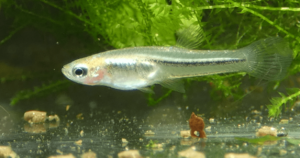Blackstripe livebearer facts for kids
Quick facts for kids Blackstripe livebearer |
|
|---|---|
 |
|
| Conservation status | |
| Scientific classification |
The Poeciliopsis prolifica, also known as the blackstripe livebearer, is a small freshwater fish. It belongs to the Poeciliidae family, which includes many popular aquarium fish like guppies. This fish is special because it is endemic to Mexico, meaning it's found only there. It's a viviparous species, which means the mother gives birth to live young instead of laying eggs. The name prolifica comes from Latin words meaning "offspring" and "fruitful," because this fish can have many babies!
Contents
About the Blackstripe Livebearer
The blackstripe livebearer is a small, shiny silver fish. Males grow to about 2 cm (0.8 in) long, while females are a bit larger, reaching about 3.5 cm (1.4 in). You can tell adult males apart from females because males have a special fin called a gonopodium. This fin is shaped like a rod and is used for reproduction.
Where It Lives
This fish lives only in Mexico, specifically on the eastern side of the Gulf of California. You can find it in the states of Sonora and Nayarit. It prefers shallow freshwater, usually less than 2 m (7 ft) deep. It can also live in slightly salty water, known as brackish water. Its favorite homes include streams, lagoons, estuaries (where rivers meet the sea), and mangrove areas. It likes places with sand, mud, or gravel at the bottom.
What It Eats and How It Reproduces
The blackstripe livebearer eats tiny bits of dead plants and animals called detritus. It also enjoys eating zooplankton, which are tiny animals that float in the water, and small insects.
One of the most interesting things about the Poeciliidae family is how they have their babies. The young fish develop inside the mother's body. For the blackstripe livebearer, the mother's body is specially adapted to carry many young. She can have up to five groups of eggs growing inside her at different stages. This means she can give birth to multiple groups of babies more often than other fish that only carry one group at a time. It's like having several nurseries inside her at once!
Conservation Status
The blackstripe livebearer lives in a small area of Mexico. It also needs very specific shallow water habitats. Because of this, its total living space is probably less than 2,000 km2 (772 sq mi). Unfortunately, new buildings and other developments are happening along the coast where it lives. This causes the loss of important habitats like mangrove forests. Because of these threats, the International Union for Conservation of Nature has listed the blackstripe livebearer as "near threatened." This means it could become endangered if its habitat continues to disappear.


